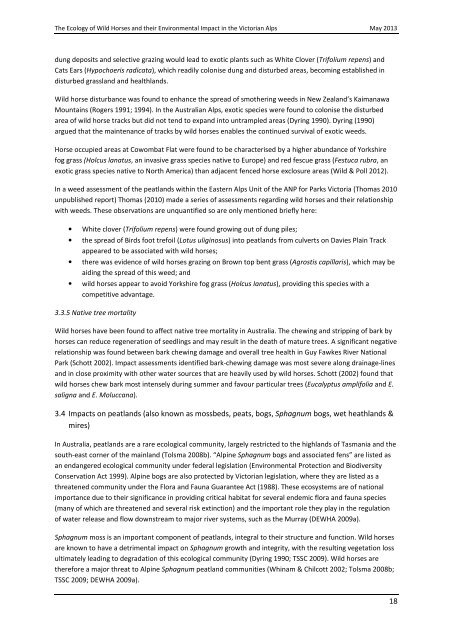The Ecology of Wild Horses and their Environmental ... - Parks Victoria
The Ecology of Wild Horses and their Environmental ... - Parks Victoria
The Ecology of Wild Horses and their Environmental ... - Parks Victoria
Create successful ePaper yourself
Turn your PDF publications into a flip-book with our unique Google optimized e-Paper software.
<strong>The</strong> <strong>Ecology</strong> <strong>of</strong> <strong>Wild</strong> <strong>Horses</strong> <strong>and</strong> <strong>their</strong> <strong>Environmental</strong> Impact in the <strong>Victoria</strong>n Alps May 2013dung deposits <strong>and</strong> selective grazing would lead to exotic plants such as White Clover (Trifolium repens) <strong>and</strong>Cats Ears (Hypochoeris radicata), which readily colonise dung <strong>and</strong> disturbed areas, becoming established indisturbed grassl<strong>and</strong> <strong>and</strong> healthl<strong>and</strong>s.<strong>Wild</strong> horse disturbance was found to enhance the spread <strong>of</strong> smothering weeds in New Zeal<strong>and</strong>’s KaimanawaMountains (Rogers 1991; 1994). In the Australian Alps, exotic species were found to colonise the disturbedarea <strong>of</strong> wild horse tracks but did not tend to exp<strong>and</strong> into untrampled areas (Dyring 1990). Dyring (1990)argued that the maintenance <strong>of</strong> tracks by wild horses enables the continued survival <strong>of</strong> exotic weeds.Horse occupied areas at Cowombat Flat were found to be characterised by a higher abundance <strong>of</strong> Yorkshirefog grass (Holcus lanatus, an invasive grass species native to Europe) <strong>and</strong> red fescue grass (Festuca rubra, anexotic grass species native to North America) than adjacent fenced horse exclosure areas (<strong>Wild</strong> & Poll 2012).In a weed assessment <strong>of</strong> the peatl<strong>and</strong>s within the Eastern Alps Unit <strong>of</strong> the ANP for <strong>Parks</strong> <strong>Victoria</strong> (Thomas 2010unpublished report) Thomas (2010) made a series <strong>of</strong> assessments regarding wild horses <strong>and</strong> <strong>their</strong> relationshipwith weeds. <strong>The</strong>se observations are unquantified so are only mentioned briefly here:• White clover (Trifolium repens) were found growing out <strong>of</strong> dung piles;• the spread <strong>of</strong> Birds foot trefoil (Lotus uliginosus) into peatl<strong>and</strong>s from culverts on Davies Plain Trackappeared to be associated with wild horses;• there was evidence <strong>of</strong> wild horses grazing on Brown top bent grass (Agrostis capillaris), which may beaiding the spread <strong>of</strong> this weed; <strong>and</strong>• wild horses appear to avoid Yorkshire fog grass (Holcus Ianatus), providing this species with acompetitive advantage.3.3.5 Native tree mortality<strong>Wild</strong> horses have been found to affect native tree mortality in Australia. <strong>The</strong> chewing <strong>and</strong> stripping <strong>of</strong> bark byhorses can reduce regeneration <strong>of</strong> seedlings <strong>and</strong> may result in the death <strong>of</strong> mature trees. A significant negativerelationship was found between bark chewing damage <strong>and</strong> overall tree health in Guy Fawkes River NationalPark (Schott 2002). Impact assessments identified bark-chewing damage was most severe along drainage-lines<strong>and</strong> in close proximity with other water sources that are heavily used by wild horses. Schott (2002) found thatwild horses chew bark most intensely during summer <strong>and</strong> favour particular trees (Eucalyptus amplifolia <strong>and</strong> E.saligna <strong>and</strong> E. Moluccana).3.4 Impacts on peatl<strong>and</strong>s (also known as mossbeds, peats, bogs, Sphagnum bogs, wet heathl<strong>and</strong>s &mires)In Australia, peatl<strong>and</strong>s are a rare ecological community, largely restricted to the highl<strong>and</strong>s <strong>of</strong> Tasmania <strong>and</strong> thesouth-east corner <strong>of</strong> the mainl<strong>and</strong> (Tolsma 2008b). “Alpine Sphagnum bogs <strong>and</strong> associated fens” are listed asan endangered ecological community under federal legislation (<strong>Environmental</strong> Protection <strong>and</strong> BiodiversityConservation Act 1999). Alpine bogs are also protected by <strong>Victoria</strong>n legislation, where they are listed as athreatened community under the Flora <strong>and</strong> Fauna Guarantee Act (1988). <strong>The</strong>se ecosystems are <strong>of</strong> nationalimportance due to <strong>their</strong> significance in providing critical habitat for several endemic flora <strong>and</strong> fauna species(many <strong>of</strong> which are threatened <strong>and</strong> several risk extinction) <strong>and</strong> the important role they play in the regulation<strong>of</strong> water release <strong>and</strong> flow downstream to major river systems, such as the Murray (DEWHA 2009a).Sphagnum moss is an important component <strong>of</strong> peatl<strong>and</strong>s, integral to <strong>their</strong> structure <strong>and</strong> function. <strong>Wild</strong> horsesare known to have a detrimental impact on Sphagnum growth <strong>and</strong> integrity, with the resulting vegetation lossultimately leading to degradation <strong>of</strong> this ecological community (Dyring 1990; TSSC 2009). <strong>Wild</strong> horses aretherefore a major threat to Alpine Sphagnum peatl<strong>and</strong> communities (Whinam & Chilcott 2002; Tolsma 2008b;TSSC 2009; DEWHA 2009a).18
















